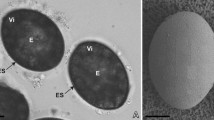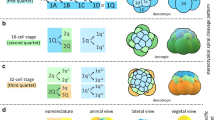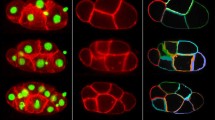Summary
The embryo of the nematode Caenorhabditis elegans is surrounded by an inconspicuous inner vitelline membrane and a prominent outer chitinous eggshell proper. We demonstrate that the complete removal of the chitinous eggshell does not interfere with successful development to yield a normal worm. The same result can be obtained when the vitelline membrane is penetrated with laser microbeam irradiation of only the eggshell proper, gently enough to permit its resealing after a while. However, when large holes are made into the eggshell the concomitantly penetrated vitelline membrane does not reseal. While early development is quite normal under these conditions, gastrulation is defective in that gut precursor cells do not migrate in properly, eventually leading to embryonic arrest. This suggests a crucial role for pattern formation of the “micro-environment” around the embryo preserved by the intact vitelline membrane. Removing both eggshell and vitelline membrane results in a string-like arrangement of founder cells and subsequent grossly abnormal cell patterns. Our experiments support the idea that the prominent eggshell proper just functions as a mechanical protection while the thin vitelline membrane directly or indirectly serves as a necessary control element affecting the positions of cells which to begin with are determined by the orientation of the cleavage spindle.
Similar content being viewed by others

References
Bird AF (1971) The structure of nematodes. Academic Press, New York
Bossinger O, Schierenberg E (1992) Transfer and tissue-specific accumulation of cytoplasmic components in embryos of Caenorhabditis elegans and Rhabditis dolichura: In vivo analysis with a low-cost signal enhancement device. Development 114:317–330
Boveri T (1910) Die Potenzen der Ascaris-Blastomeren bei abgeänderter Furchung. Festschrift R. Hertwig, Fischer, Jena:133–214
Brenner S (1974) The genetics of Caenorhabditis elegans. Genetics 77:71–94
Cole TS, Schierenberg E (1986) Laser microbeam-induced fixation for electron microscopy: Visualisation of transient developmental features in nematode embryos. Experientia 42:1046–1048
Denich KTR, Schierenberg E, Isnenghi E, Cassada R (1984) Cell-lineage and developmental defects of temperature-sensitive embryonic arrest mutants of the nematode Caenorhabditis elegans. Roux's Arch Dev Biol 193:164–179
Edgar LG, McGhee JD (1988) DNA synthesis and the control of embryonic gene expression in C. elegans. Cell 53:589–599
Goldstein B (1992) Induction of gut in Caenorhabditis elegans embryos. Nature 357:255–257
Laufer JS, Bazzicalupo P, Wood WB (1980) Segregation of developmental potential in early embryos of Caenorhabditis elegans. Cell 19:569–577
Laufer JS, Ehrenstein G (1981) Nematode development after removal of egg cytoplasm: Absence of localized unbound determinants. Science 211:402–405
Priess JR, Hirsh DI (1986) Caenorhabditis elegans morphogenesis: The role of the cytoskeleton in elongation of the embryo. Dev Biol 117:156–173
Priess JR, Thomson JN (1987) Cellular interactions in early C. elegans embryos. Cell 48:241–250
Schierenberg E (1984) Altered cell division rates after laser-induced cell fusion in nematode embryos. Dev Biol 101:240–245
Schierenberg E (1987) Reversal of cellular polarity and early cell-cell interaction in the embryo of Caenorhabditis elegans. Dev Biol 122:452–463
Schierenberg E (1988) Localization and segregation of lineage-specific cleavage potential in embryos of Caenorhabditis elegans. Roux's Arch Dev Biol 197:282–293
Schierenberg E, Miwa J, von Ehrenstein G (1980) Cell lineages and development of temperature-sensitive embryonic arrest mutants in Caenorhabditis elegans. Dev Biol 76:141–159
Schierenberg E, Strome S (1992) The establishment of embryonic axes and determination of cell fates in embryos of the nematode Caenorhabditis elegans. Seminars Dev Biol 3:25–33
Schierenberg E, Wood WB (1985) Control of cell-cycle timing in early embryos of Caenorhabditis elegans. Dev Biol 107:337–354
Schlicht P, Schierenberg E (1991) Altered establishment of cell lineages in the Caenorhabditis elegans embryo after suppression of the first cleavage supports a concentration-dependent decision mechanism. Roux's Arch Dev Biol 199:437–448
Schnabel R (1991) Cellular interactions involved in the determination of the early C. elegans embryo. Mech Dev 34:85–100
Schüpbach T (1987) Germ line and soma cooperate during oogenesis to establish the dorsoventral pattern of egg shell and embryo in Drosophila melanogaster. Cell 49:699–707
Seidl C, Bauer M, Moritz KB (1988) Chromatin diminution and early cleavage in Parascaris uniualens (Nematoda). Roux's Arch Dev Biol 197:307–320
Stein D, Roth S, Vogelsang E, Nüsslein-Volhard C (1991) The polarity of the dorsoventral axis in the Drosophila embryo is defined by an extracellular signal. Cell 65:725–735
Sulston JE, Schierenberg E, White J, Thomson N (1983) The embryonic cell lineages of the nematode Caenorhabditis elegans. Dev Biol 100:64–119
Wolf N, Priess J, Hirsh D (1983) Segregation of germline granules in early embryos of Caenorhabditis elegans: an electron microscopic analysis. J Embryol Exp Morphol 73:297–306
Wood WB (1991) Evidence from reversal of handedness in C. elegans embryos for early cell interactions determining cell fates. Nature 349:536–538
Author information
Authors and Affiliations
Additional information
Correspondence to: E. Schierenberg
Rights and permissions
About this article
Cite this article
Schierenberg, E., Junkersdorf, B. The role of eggshell and underlying vitelline membrane for normal pattern formation in the early C. elegans embryo. Roux's Arch Dev Biol 202, 10–16 (1992). https://doi.org/10.1007/BF00364592
Received:
Accepted:
Issue Date:
DOI: https://doi.org/10.1007/BF00364592



